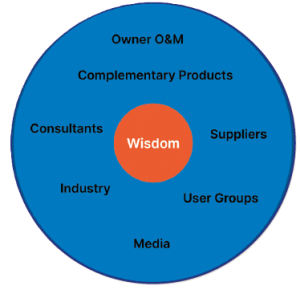AI may be transforming valve operations and research, but progress lies in Wisdom Enhanced Process Solutions (WEPS) where smart tech meets human insight.
By Robert McIlvaine – CEO – McIlvaine Company
Artificial intelligence (AI) is already changing the way valves are purchased, operated, and even how market research is conducted. It would be a mistake to think that we are at a stage where AI will replace human wisdom. In fact, decision-making will be driven by Wisdom Enhanced Process Solutions (WEPS). Smart technology can be likened to a PhD degree, but WEPS is the ultimate use of that degree.
What is WEPS?
Wisdom Enhanced Process Solutions can provide the lowest total cost of ownership (LTCO). This may have the latest automation, but human experts are still needed to maximize the results. There are individual WEPS and combinations available. The valve solution is integrated with process equipment and automation tools. The continuing operation of the process to achieve the lowest total cost of ownership depends on human intervention as needed. Much of this intervention can be standardized, but there is no substitute for the intervention of an expert.
A process combination could be valves, pumps, and filters. It would also contain the PLCs, instruments, and sensors needed for the continuing operation with the least amount of human intervention. There are three categories related to the combination. One option is a valve company that relies on the plant automation supplier. The second is the valve company providing the smart valve portion of automation. The third is a valve company that offers the complete automation of the process.
Suppliers of both control valves and automation include Emerson, Azbil and Andritz. Andritz is currently very competitive. It manufactures all the equipment and the automation, so it provides the complete range of wisdom that is needed. Andritz has been a manufacturer of filters, air pollution control, and various process equipment for decades, and has acquired additional companies.
It has also incorporated automation products under the name Metris as part of its solutions, thus possessing the ultimate tool to insert wisdom in the process. Other valve manufacturers, too, are providing at least some of the automation through collaboration agreements with automation suppliers.
The control valve wisdom is a principal factor in the process. Azbil has a big advantage since it offers automation and analytical services for process equipment.
For example, in polymer plants, it utilizes the automation and analytics for the mixers, extruders and control valves.

The lowest total cost of ownership of a mixer operation is in part the accuracy of viscosity measurements and the response time. Azbil also incorporates the wisdom of the operators by digitizing their responses as they make the rounds of the system.
The control valve manufacturer needs the input from industry experts in anticipating future needs for the valves. The wisdom of the control valve manufacturer is also needed in evaluating opportunities to improve seals, materials of construction, and other components.
A WEPS decision is going to be more favorable to the valve company whose wisdom is incorporated in the solution. This starts with the design of the valve itself, regardless of the application. The best way to operate and maintain the valve should be at the very least reflected in algorithms available from the valve manufacturer.
At the next level, the valve manufacturer should reflect the ways to best operate and maintain the valve in specific processes and applications, such as heat recovery steam generators. The valve company wisdom needs to be reflected in the discussions with prospects prior to the quotation.
They would then need to assign one or more sales or technical people to become an expert in each important application and process. This input will be valuable prior to the quotation (and also available on an ongoing basis).
Market Research with AI
Artificial Intelligence is already allowing market research to be much more accurate. There are some fundamental changes in the approach.
Bottoms-Up vs. Top-Down Marketing Strategies
Most market research in the past has been done on a top-down basis. In the future, it will increasingly use a bottoms-up strategy with individual prospects being the bottom level and predictions made about the potential market share for each prospect. If the market is growing at 5% per year and the value life is 10 years, then the replacement valve market is twice as large as the new valve market. This allows the vendors to know exactly who the prospects are for much of the total market.
Additionally, 95% of the valves are purchased by companies that already have experience with valve operation. The bottoms-up approach is not only the most accurate way to determine the market, but it’s the best way to provide sales people with properly targeted prospects.
New Metrics for Market Research Numbers
In the past, market research has potentially failed to provide very precise definitions for revenue numbers. In the future, precise definitions will be needed, and there are some new metrics. In the past, the reports have provided revenues and volume.
With valves of varying sizes, volume is meaningless. However, volume adjusted revenue (VAR) is a better volume metric. Since the list price is known, the actual volume can be determined. Volume adjusted revenue can be modified to actual prices in two steps. The first would be the average discount on standard prices. The second is the lower pricing in developing countries. The price for a valve in India may be at least 30% lower than that same valve sold in the United States or Europe.
Earnings Before Interest, Taxes, Depreciation, and Amortization (EBITDA)
The top valve companies are achieving EBITDA of 30%. The combination of VAR and discounts is a way to establish a good statistical basis for accurate forecasting.
Summary
Artificial Intelligence has changed the valve market and the way to pursue it. The structure for valve companies would be to utilize the WEPS, which will be most profitable. Decisions will need to be made about how each Hub is approached to obtain the 30% EBITDA and maximize sales.



